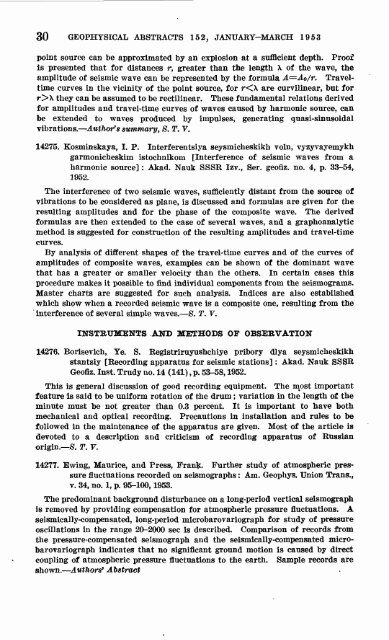Geophysical Abstracts 152 January-March 1953
Geophysical Abstracts 152 January-March 1953
Geophysical Abstracts 152 January-March 1953
Create successful ePaper yourself
Turn your PDF publications into a flip-book with our unique Google optimized e-Paper software.
30 GEOPHYSICAL ABSTRACTS <strong>152</strong>, JANUARY-MARCH <strong>1953</strong><br />
point source can be approximated by an explosion at a sufficient depth. Proof<br />
is presented that for distances r, greater than the length X of the wave, the<br />
amplitude of seismic wave can be represented by the formula A=Ao/r. Travel-<br />
time curves in the vicinity of the point source, for r\ they can be assumed to be rectilinear. These fundamental relations derived<br />
for amplitudes and travel-time curves of waves caused by harmonic source, can<br />
be extended to waves produced by impulses, generating quasi-sinusoidal<br />
vibrations. Author's summary, 8. T. V.<br />
14275. Kosminskaya, I. P. Interferentsiya seysmicheskikh voln, vyzyvayemykh<br />
garmonicheskim istochnikom [Interference of seismic waves from a<br />
harmonic source]: Akad. Nauk SSSR Izv., Ser. geofiz. no. 4, p. 33-54,<br />
1952.<br />
The interference of two seismic waves, sufficiently distant from the source of<br />
vibrations to be considered as plane, is discussed and formulas are given for the<br />
resulting amplitudes and for the phase of the composite wave. The derived<br />
formulas are then extended to the case of several waves, and a graphoanalytic<br />
method is suggested for construction of the resulting amplitudes and travel-time<br />
curves.<br />
By analysis of different shapes of the travel-time curves and of the curves of<br />
amplitudes of composite waves, examples can be shown of the dominant wave<br />
that has a greater or smaller velocity than the others. In certain cases this<br />
procedure makes it possible to find individual components from the seismograms.<br />
Master charts are suggested for such analysis. Indices are also established<br />
which show when a recorded seismic wave is a composite one, resulting from the<br />
interference of several simple waves. S. T. V.<br />
INSTBUMENTS AND METHODS OF OBSERVATION<br />
14276. Borisevich, Ye. S. Registriruyushchiye pribory dlya seysmicheskikh<br />
stantsiy [Recording apparatus for seismic stations]: Akad. Nauk SSSR<br />
Geofiz. Inst. Trudy no. 14 (141), p. 53-58,1952.<br />
This is general discussion of good recording equipment. The most important<br />
feature is said to be uniform rotation of the drum; variation in the length of the<br />
minute must be not greater than 0.3 percent. It is important to have both<br />
mechanical and optical recording. Precautions in installation and rules to be<br />
followed in the maintenance of the apparatus are given. Most of the article is<br />
devoted to a description and criticism of recording apparatus of Russian<br />
origin. 8. T. V.<br />
14277. Bwing, Maurice, and Press, Frank. Further study of atmospheric pres<br />
sure fluctuations recorded on seismographs: Am. Geophys. Union Trans.,<br />
v. 34, no. 1, p. 95-100,<strong>1953</strong>.<br />
The predominant background disturbance on a long-period vertical seismograph<br />
is removed by providing compensation for atmospheric pressure fluctuations. A<br />
seismically-compensated, long-period microbarovariograph for study of pressure<br />
oscillations in the range 20-2000 sec is described. Comparison of records from<br />
the pressure-compensated seismograph and the seismically-compensated micro<br />
barovariograph indicates that no significant ground motion is caused by direct<br />
coupling of atmospheric pressure fluctuations to the earth. Sample records are<br />
shown. Authors' Abstract

















